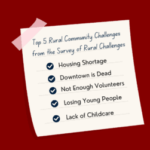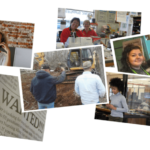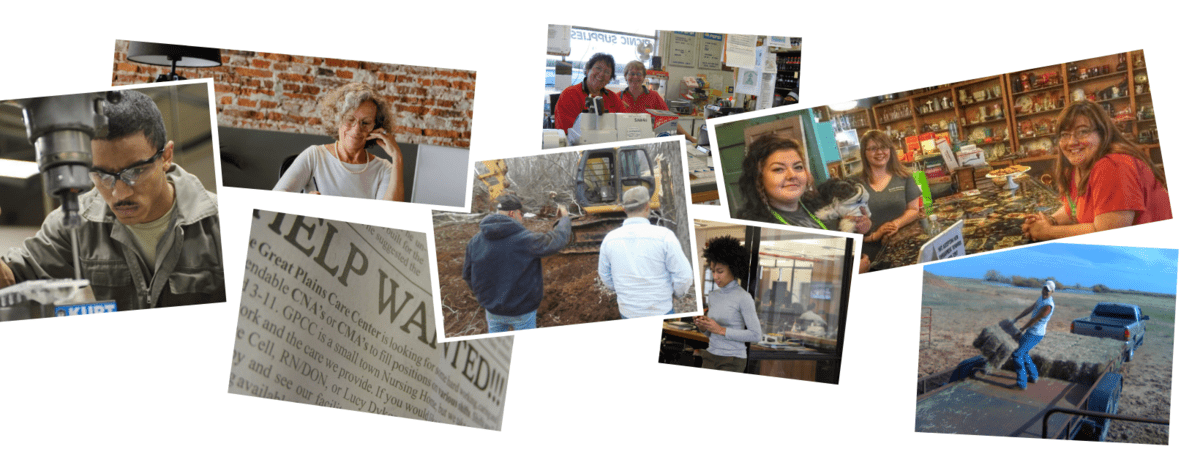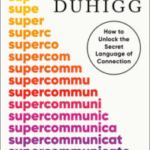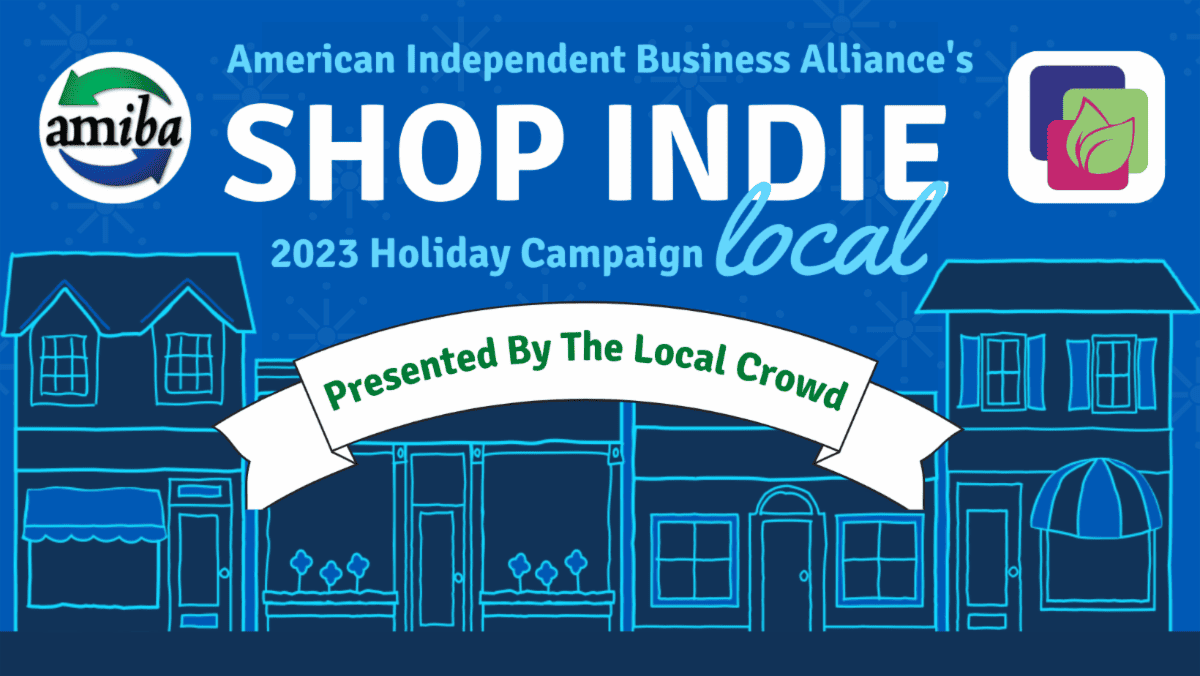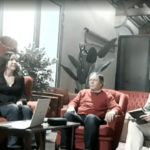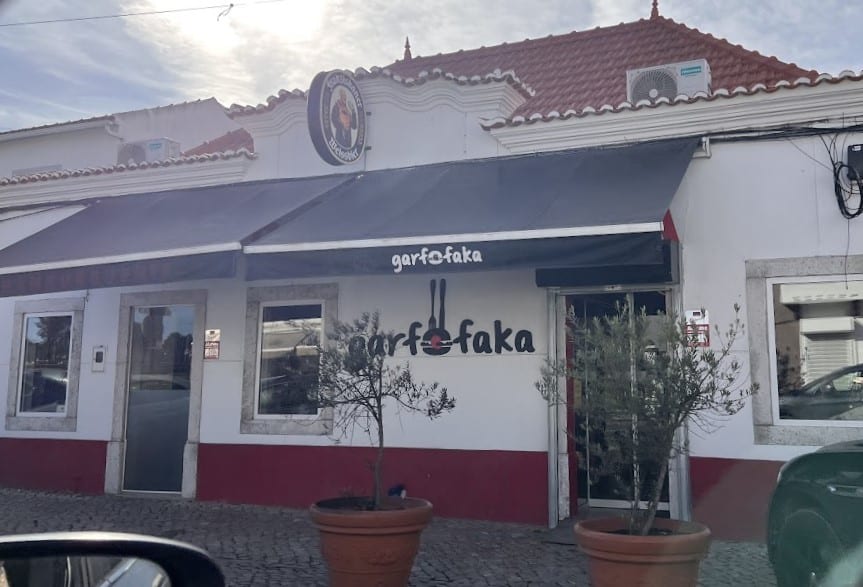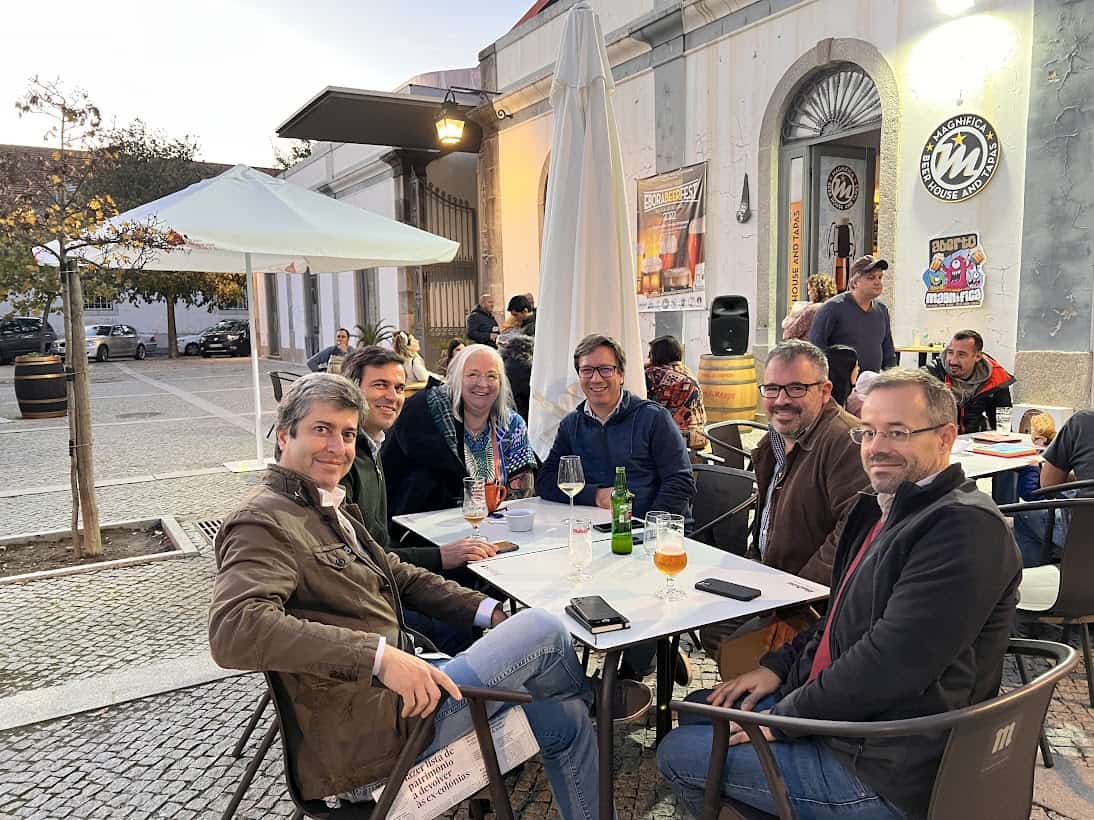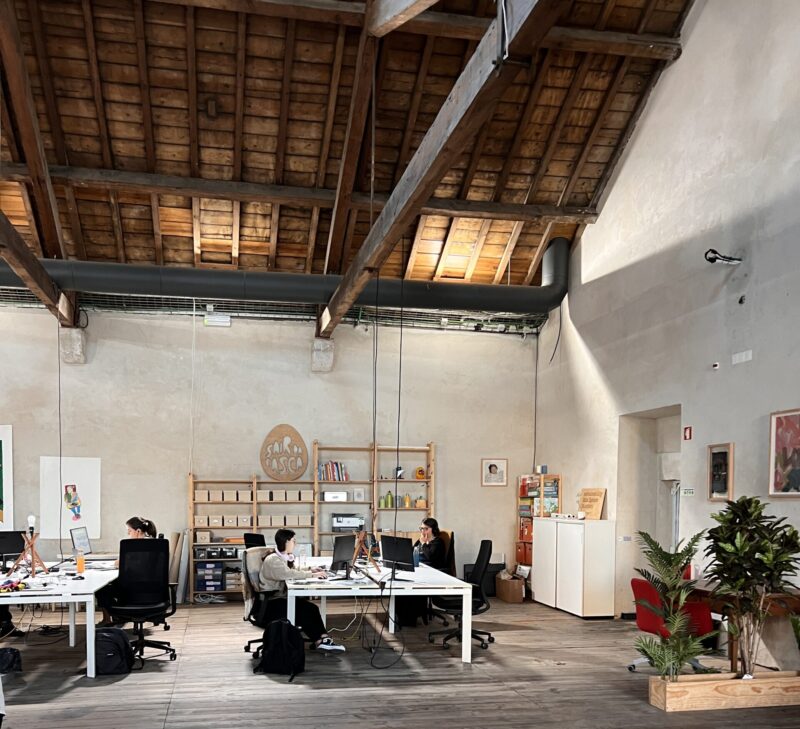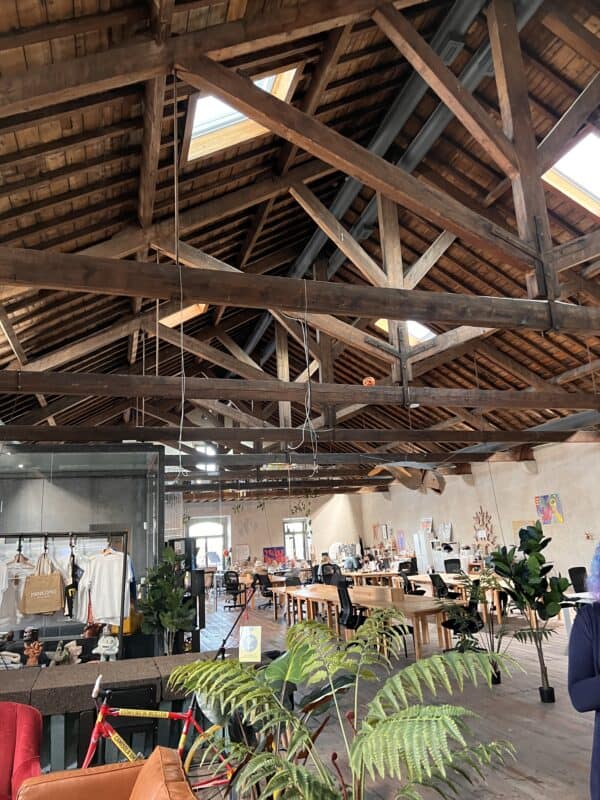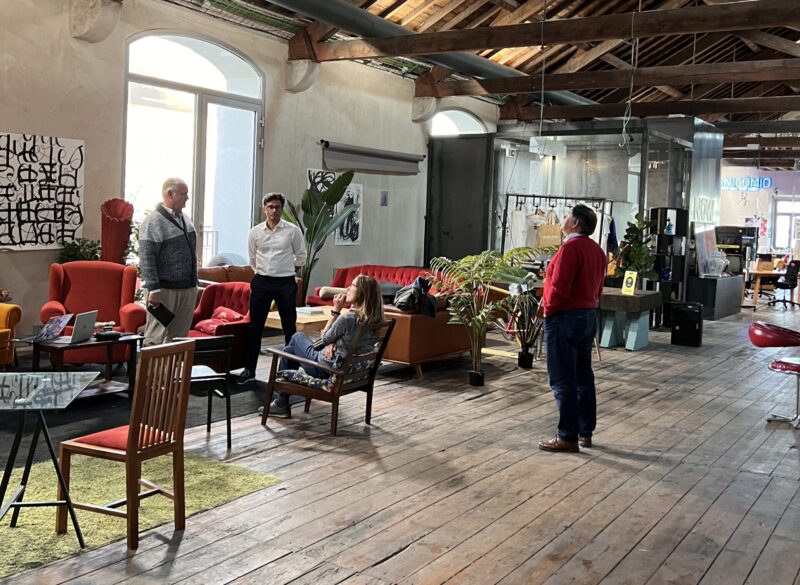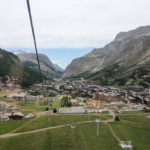Uncategorized
Beyond the Big Banks: How rural small businesses can Move Their Money locally
The “Move Your Money” campaign wants you to shift your financial resources to local banks and investment opportunities. That makes a lot of sense for small town businesses who care about having a thriving local economy. The 2024 Move Your Money Campaign The American Independent Business Alliance (AMIBA) has been at the forefront of the […]

The “Move Your Money” campaign wants you to shift your financial resources to local banks and investment opportunities. That makes a lot of sense for small town businesses who care about having a thriving local economy.
The 2024 Move Your Money Campaign
The American Independent Business Alliance (AMIBA) has been at the forefront of the “Move Your Money” campaign, offering resources and support for those interested in making the switch to local banking. This year, AMIBA has emphasized the critical role that local banks and credit unions play in fostering economic resilience within small towns and rural communities. By banking locally, businesses and individuals not only enjoy more personalized service but also contribute to a financial ecosystem that directly benefits their immediate environment.
Key Points for Rural Small Businesses
For rural small businesses, the decision to bank locally can have far-reaching implications. Here are some practical benefits from moving your money:
- Strengthening Local Economies: Every dollar deposited in a local bank or invested in a local business circulates within the community, amplifying its economic impact. This circulation helps to create jobs, fund local projects, and support the growth of other small businesses.
- Access to Tailored Financial Services: Local banks often have a deeper understanding of the unique challenges and opportunities faced by rural businesses. This insight allows them to offer more tailored financial products and advice, which can be crucial for businesses looking to navigate the complexities of rural economies.
- Building Community Connections: Banking locally facilitates relationships that go beyond mere transactions. It fosters a sense of community and mutual support, where businesses and banks work together towards common goals.
- Advocacy and Support: AMIBA and other organizations provide a wealth of resources for businesses interested in moving their money. From virtual screenings that explore cooperative economies to discussions on local investing, these platforms offer valuable insights and networking opportunities.
How local is your bank?
As rural and small town banks merge and change, it can be tough to tell if your once-local bank really is still local. With regulations pushing small town banks to buy other small banks, your bank now might be semi-local or owned somewhere else. But does that make them a bad neighbor?
Even regionally owned banks are better for your community than giant national or international banks. Here are some practical ways to decide just how local your local bank acts.
- Check the current ownership structure: Look for information about the bank’s ownership structure on their website or by contacting the bank directly. Community-owned banks are typically owned by share-holding local residents, while regional or commercial banks may be owned by larger corporations or shareholders from outside the community.
- Research the recent history: Local banks often have a long history in the community, but may have shifted priorities if ownership changed. Check the bank’s website or media stories for information about its recent community-focused initiatives.
- Visit the local branch: Visit in person to get a sense of the bank’s community involvement. Look for local causes featured in the lobby. See what local ties are visible.
- Ask for recommendations: Reach out to other local businesses, community leaders, or residents to ask for their recommendations on local banks. They may have personal experiences or insights that can help you make an informed decision.
How to move your money
Check the checklist in Move Your Money and Bank Local.
Advocate for Local Banking
Catch up with additional local banking resources from the Institute for Local Self-Reliance.
The “Move Your Money” campaign is more than just a call to action; it’s a movement towards sustainable, community-focused banking. For rural small businesses, the benefits of participating extend beyond financial gains. It’s about building a resilient local economy that can withstand the ebbs and flows of the broader financial system.
2024 Survey of Rural Challenges Is Open!
These 10 questions will provide information to many organizations and people on what is challenging for rural communities. Are you rural? This survey is for you. SmallBizSurvival.com and SaveYour.Town are conducting the 10th-anniversary edition of the Survey of Rural Challenges! Take the Survey of Rural Challenges. Spread the word Could you help us spread the word on […]
These 10 questions will provide information to many organizations and people on what is challenging for rural communities. Are you rural? This survey is for you.
SmallBizSurvival.com and SaveYour.Town are conducting the 10th-anniversary edition of the Survey of Rural Challenges! Take the Survey of Rural Challenges.
Spread the word
Could you help us spread the word on the Survey of Rural Challenges to as many people as possible? You could repost, add to your newsletter, print it in the local newspaper or share in meetings and presentations now through the end of May 2024.
Share this link to share the survey: https://saveyour.town/survey2024
Why you want to take the Survey
Your answers to the Survey of Rural Challenges will:
Prepare better services for rural communities.
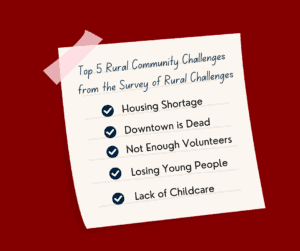
2023 Top Five Rural Challenges
“It gives us great insight as we continue to refine our services geared toward small rural communities.” Marci Goodwin from Peoria IL said on LinkedIn
Help others to know what the real issues are in rural communities.
“As we work to listen and then tackle these important issues, data like this is extremely helpful. “Jason Duff
Assist those working in rural to make changes that will matter.
“I am experimenting with an organizational pivot towards expert entrepreneur coaching for rural co-operatives’ rural businesses and away from supporting written business plans. Your survey results and our conversations helped me clarify how we describe that.” Heather Hallgrimson, Saskatchewan, Canada
Have results that will help other organizations address the needs of rural people.
“Save Your.Town and Small Biz Survival’s Survey of Rural Challenges noted Rural business people needed help with marketing, starting a business, or receiving economic development incentives.” American Indian Alaska Native Tourism Association
“Lack of housing, inactive downtowns, population losses, losing young people, and childcare ranked the highest as rural community challenges. What are the next steps we need to take in Casselton (besides the grocery store because I know that’s what you’re going to say and the need for a grocery store is a given)?” Char Gust, Casselton City Council Member
Direct the conversation in important ways.
“If you care about rural people and places, this is a good opportunity to share your thoughts and help inform the conversation.”Tyson Ochsner, Professor at Oklahoma State University
“We use the results to create practical steps that help you shape a better future for your town. Because you tell us what topics rural people most want help with, your responses also get shared out to others who work with rural communities and in articles and media stories,” said Becky McCray, cofounder of SaveYour.Town
Take the Survey of Rural Challenges today!
How the survey works:

Communi-Tea from Estherville News
The survey will collect voluntary responses online in the 1st and 2nd quarter of 2024. The survey is open to rural people globally: USA, Canada, Australia, New Zealand, or any other country. Anyone who lives or works in a small town can answer. More than 1700 people answered the survey in previous years. Results from 2015, 2017, 2019, 2021, and 2023 and links to media coverage are available at https://saveyour.town/survey-of-rural-challenges-news
Helping us get more survey responses gives you more to do with the survey later.
Amy Peterson, Estherville News (Iowa) said,“Our newspaper used the Survey of Rural Challenges as a starting point to do some interviews with local people about their challenges. Our series earned second place as Best Series in the Iowa Newspaper Association awards. I love the Survey of Rural Challenges as a journalist, and we’ll have to find a new way to use the numbers to take the pulse of our community.”
Amy started the series Spilling the Commun-tea in the local paper.
Take the Survey of Rural Challenges today!
Improving the rural workforce: small town stories and takeaways
Takeaways for improving rural workforce: Bring together students, employers and multiple levels of education Build and document employee skills with micro-credentials Use apprenticeships to build skills, increase awareness of local job options Stitch together multiple programs to build your own workforce To add a new program in the public schools, hire dedicated program staff (at […]
Takeaways for improving rural workforce:
- Bring together students, employers and multiple levels of education
- Build and document employee skills with micro-credentials
- Use apprenticeships to build skills, increase awareness of local job options
- Stitch together multiple programs to build your own workforce
- To add a new program in the public schools, hire dedicated program staff (at least part time)
At the Teeny Tiny Town Summit held in Woodward, Oklahoma, a panel of local people addressed rural workforce challenges and what actions they were taking to address them.
The panelists were
- Barclay Holt, High Plains Technology Center, Woodward, Oklahoma
- Joe Cox, Oklahoma Works at Oklahoma Department of Commerce
- Brad Griffiths, Oklahoma State Regents for Higher Education
- Liz Leaming, Ponca City Development Authority, Ponca City, Oklahoma
And I’ll share some additional information from:
- Roger Knak, Fairview Regional Medical Center, Fairview, Oklahoma
Bring together students, employers and multiple levels of education
To encourage local students to consider additional local career options, High Plains Technology Center offers TAP (Technical Applications Program) for sixth through 10th graders, Barclay Holt said. The project is for career exploration that leads into the full-time training programs at HPTC. Think hands-on welding, tool and equipment use. All of the kids get to see and participate in all of the education areas. It is held at Woodward schools in their existing buildings, and at other schools across the HPTC district.
This brings together the two levels of education (career tech and public schools) in a way that didn’t require a lot of new investment. They also partner with community leaders, business owners, and parents.
Build and document employee skills with micro-credentials
Brad Griffiths explained UpskillOK.org, a micro-credentialing program of the Oklahoma State Regents for Higher Education. It offers a different way to approach employee training and development. Employers can collaborate with Oklahoma colleges and universities to develop a standardized credential for specific career skills. Other states and territories offer similar programs.
Just a few examples from the hundreds of current micro-credentials include:
- Government and Not-for-Profit Accounting
- Artificial Intelligence – Game Developer
- Mechanical Design
- Court Reporting Skills
Many of these also connect to industry certifications, like Google Career Certificates and CompTIA.
Higher education tends to measure courses in credit hours, and these micro-credentials include nine credit hours. These are smaller than the university certificates offered at some institutions, which take more hours. Micro-credentials can include learning through activities and projects, so they’re looking to connect with apprenticeship programs for work-based learning.
Use apprenticeships to build skills, increase awareness of local job options
Oklahoma Works Joe Cox has worked with local employers across the state to start apprenticeship programs in local businesses. When he started, most existing apprenticeships were in Oklahoma City or other metro areas. He has worked to expand to rural communities, including Watonga, Oklahoma.
He said it is a program that takes someone not necessarily fully qualified and gives them a chance at employment. The program has 97% retention rate. The apprenticeship can be a one to four year program. Cox often connects employers with the Oklahoma Department of Rehabilitation Services to help their clients connect with apprenticeship jobs.
Connecting students to existing local employers and jobs helps increase the chances to retain young people in rural communities.
Stitch together multiple programs to build your own workforce
Roger Knak with Fairview Regional Medical Center, Fairview, Oklahoma, presented on the health care panel, and he addressed how they build their workforce. Because they employ people in a variety of fields, they have to work with multiple workforce programs to grow their employees’ skills.
- They provide stipends to support their nurses with lower level CNA certification to complete their higher level LPN degrees.
- For their IT needs, they have a paid internship to work with their full time IT staff person.
- Their lab technicians complete online training through Barton County Community College from Kansas.
Roger told me that he wasn’t aware of the Oklahoma Works apprenticeship programs until this event. He planned to check how he could connect his IT internship to the state program. That is the power of holding local events and encouraging local networking.
Grow your own workforce
Ponca City, Oklahoma, has created multiple workforce programs. Liz Leaming from Ponca Works talked about growing their own workforce.
Ponca Works connects high school seniors who do not plan to attend college with local employers. Once per month all year the seniors meet with representatives from employers for Cookies and Careers. This encourages students to pursue local employment even if they don’t plan on college.
Ponca Works also uses augmented reality to give tours of local companies in a safer way. Some workplaces may not be set up for large group tours, or may have dangerous equipment. Using AR, students can get a virtual experience without compromising their safety.
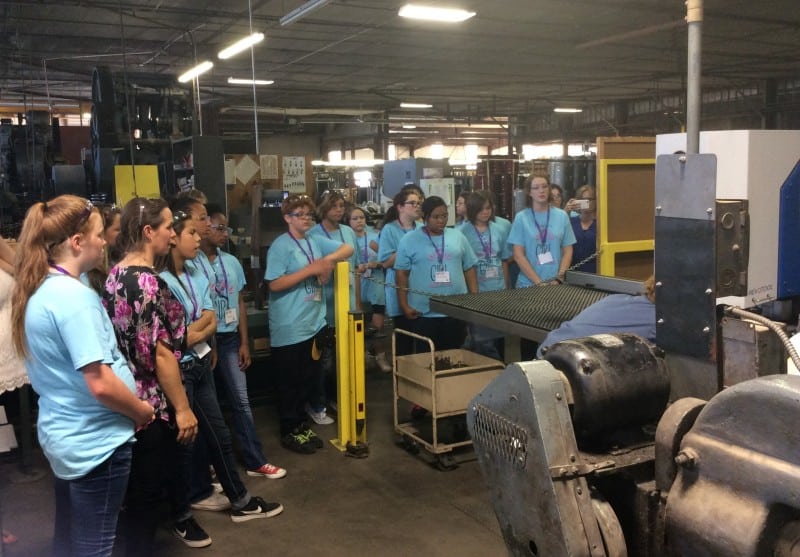
Some workplaces can be toured, like Lindsey Manufacturing, maker of central vacuum systems. Other workplaces are safer to tour by Augmented Reality instead. Photo courtesy of Ponca City Development Authority.
Ponca City also offers a Girl Power STEAM camp. Here is how they explained the origin of the project:
When Ponca Works began there was a job posting for an office position with about 100 applicants, all female. At the same time there were dozens of jobs in the technical field that were open. It wasn’t a surprise, but more of a wake up call, at the large gap of girls and STEM careers. Girl Power exposes middle school girls to strong women with STEM careers in our community, hands on activities that teach exploration in science, technical skills, problem solving, critical thinking, and much more. We also tour facilities in Ponca City that offer careers in those fields. Our first campers will be entering the workforce next year, and we are excited to see what they are choosing to pursue.
Ponca Works also led a project to standardize all education and career players on a single evaluation tool so students could be evaluated once and move through any of the local workforce programs.
Liz mentioned that lots of kids are interested in forensic science, but it is a massively under-employed field with no direct employment opportunities locally. Drawing on similar skills, some students have been redirected into microbiology jobs which are available locally, such as the local manufacturer that needs lab analysis for their animal food supplements.
The Ambassador Program at Ponca Works trains younger employees at local businesses to share their story of local career opportunities with high school students.
To add a new program in the public schools, hire dedicated program staff (at least part time)
Ponca Works also offers a Wildcat Internship for juniors and seniors in high school. Students spend 1 to 3 hours a day at an employer. Around 30% of those students are paid. At the end of the program, around 10% get hired. There are 108 participating this year.
Before they hired a dedicated staffer at the schools, internship enrollment lagged. People at the school simply did not have capacity to manage yet another program.
Actions for rural employers to build their local workforce:
- Establish apprenticeship and internship programs: Apprenticeships and internships can help build skills and increase awareness of local job options. Look for state programs and projects to build support for internships and apprenticeships.
- Connect with multiple workforce development programs: Employers can provide stipends for employees to continue their education, connect with higher education micro-credentials and partner with educational institutions across geographic boundaries for specialized education.
- Engage with local schools: Employers can partner with local schools to offer programs to help students gain hands-on experience in various fields. Connect with high school seniors who do not plan to attend college and offer them employment opportunities. This can help retain young people in rural communities.
- Promote STEAM education: Employers can support local initiatives, camps, and programs that exist in the community.
- Hire dedicated program staff: If adding a new program in public schools, it’s important to hire dedicated program staff to promote the program effectively.
- Standardize evaluation tools: Work with educators and career specialists to agree on a single evaluation tool so students can take a single evaluation to use at any of the programs.
- Engage in local networking: Employers can participate in local events and networking to learn about new programs and opportunities.
More resources
- Grow Your Own Workforce, Katherine Long, CEcD, Ponca City Development Authority
- Reaching “at risk” kids for local jobs, two real-world examples, SmallBizSurvival
- Finding Good Employees: Rural Workforce Trends video, SaveYour.Town
99% of the best things you can do for your town don’t require anyone’s permission
Building community in your small town sounds like a daunting task. It’s easy to get bogged down, thinking there’s too much to do, that you’d need too many permissions or it would take too much money. The reality of building community is it’s a change of mindset to Take Small Steps. 99% of the best […]

Building community in your small town sounds like a daunting task. It’s easy to get bogged down, thinking there’s too much to do, that you’d need too many permissions or it would take too much money. The reality of building community is it’s a change of mindset to Take Small Steps.
99% of the best things you can do for your town don’t require anyone’s permission.
I’ve seen lists before of things you can do for your city, but none written for small towns. Let’s fix that. Here are 100+ small-town-approved ideas to build community.
- Hang out downtown, in the park, in plazas and pocket parks. Take a book or a snack. Invite friends. Have conversations.
- Cook extra and share with a neighbor.
- Introduce yourself when meeting someone new.
- Smile and remind people of your name.
- Walk. Park and walk to run errands. Park further from where you want to go.
- Hold a (music) jam session in your neighborhood or downtown.
- Bike. Bike your errands. Bike to work. Bike to the park.
- Make a list of everything in your town you can walk or bike to in 30 minutes. You might be surprised.
- Attend the arts and music events at local schools and colleges.
- Go to community performances and events. Cheer. Share praise online.
- Eat outside at local cafes and at picnic tables and benches downtown.
- Sit down for a meal with someone not like you. Someone from the community who is from a significantly different background, ethnicity, class, income level, or education. Listen.
- Spend more time in your front yard and on your front porch.
- Dress the front of your house to be inviting. Set out extra chairs and invite friends to join you.
- Drop in on the library and ask about what they have besides books.
- Start a hashtag for sharing good news and ideas in your town. Comment, like and share good things.
- Take pictures of things you like in your town and share them online.
- Shop the farmers’ market. Try something. Share pics online of what you cook.
- Walk into a local store. Take 5 friends. Spend $10 each.
- Walk into a local store. Take 2 pictures of something you didn’t know they had for sale. Post online.
- Start or join a walking or running group.
- Make and share a list of every public walking trail or meditation path in your town including those in parks, on church grounds, at schools or colleges, and along public waterways.
- Enter something you’ve created or grown in the county fair.
- Start a community betterment group. Pick items from this list or make up your own ways to improve your town.
- Plant a tree.
- Plant flowers in unexpected places.
- Dig and divide plants and put the new plants where others can see and appreciate them. Ask neighbors if they have plants you can divide and share.
- Start a positive hashtag for your community like #IfOurTown (#IfAlva or #IfPullman) and post positive things with it.
- Participate in art walks, downtown strolls and evening events.
- Hang string lights.
- Start a rock hunt. Find some small rocks, paint them and hide them outdoors downtown. Make a hashtag or online group so people can post photos when they find them.
- Plant an extra row in your garden to share.
- Grow a community garden with neighbors.
- Set up a table in a public place or at a farmers market to give away extra produce.
- Donate extra produce to the food bank.
- Put googly eyes on something. Use non-destructive adhesive like poster tack.
- Talk to your neighbors.
- Lead a photo walk. Invite friends to walk around and take pictures of good things. Notice things you like and share them.
- Host a street dance. Or empty lot dance or parking lot dance or…
- Start a sing-along. Anywhere, anytime.
- Wash the outside windows on an empty building.
- Pull weeds from public flower beds and boxes.
- Shovel snow for a neighbor.
- Talk to young people. Ask about what they want in your community.
- Sweep your own sidewalk.
- Find something that needs a simple repair, like a wooden flower box or a loose board on an empty building. Repair it.
- Work outdoors. Take your laptop for coworking in the park or at tables downtown.
- Carry a small trash bag when you walk or run to pick up trash.
- Send written thank you cards and letters to people who do good things in town.
- Start a Coffee and Calendars gathering. Invite people for coffee and ask them to bring the calendars and plans for any groups, organizations or boards they work with. Share community events and plans with each other.
- Make a cardboard playground. All you need is cardboard, scissors, tape, random material and stuff, and kids.
- Host a pop-up business from a local crafter or artist in a building or business you own.
- Plant herbs in empty flower boxes or pots.
- Paint a temporary mural on cloth, cardboard, coroplast (plastic sign material), or sheet metal. Hang it using magnets, sticky tack, or bungee cords.
- Put up directional signs to all kinds of things: parks, murals, art, businesses.
- Use your town’s waterfront, creek, lake or river. Mow and clean up a small patch and hold an open picnic to start. Talk about what you’d like to do or see. Can you boat or kayak?
- Add benches.
- Host a game night with your neighbors in your home.
- Host a game day at a local park.
- Create chalk art on sidewalks, bare walls, and retaining walls.
- Display fabric art everywhere.
- Host lawn croquet and invite your neighbors.
- Welcome newcomers to your town with a dinner or event.
- Hire a young person to help you out.
- Make and share a list of free activities in your town like public fishing, bird watching, or outdoor exercise equipment.
- Start a book club, painting club, or learning club.
- Feature local art for sale on the walls of your business.
- Paint something that needs it like a picnic table, bench or pole.
- Barter and trade with each other. Loan each other tools.
- Create a library of things: tools, cake pans, kitchen tools, musical instruments, all free to check out like library books.
- Start an Old Geezers Club, where older folks can bring their tools and share a workspace with anyone who wants to make something.
- Hold a repair cafe: bring together people who can fix things (including sewing) and let anyone bring anything that needs fixed.
- Make a free-stuff wall or space.
- Put out books for free in neighborhoods that are far from the library or near a gathering place like benches.
- Listen to stories from older people and people who are new in town. Document and share them.
- Hold a potluck with your neighbors.
- Start a poetry reading or writing marathon.
- Create a nature viewing area on your property.
- Return your broken paving (like cracked parking lots) to durable drivable grass.
- Start practicing yoga in the park and invite a friend.
- Give away extra plants or pots.
- Host a block party on your block.
- Host a community dinner, lots of people at one long table. Put conversation starters on the tables.
- Fill a box with outdoor toys. Place it at a local park in the mornings, and bring it in in the evening.
- Host neighborhood parents for an evening wrapping presents and putting together toys before Christmas.
- Show a movie outdoors.
- Mow an empty lot or a neighbor’s lawn.
- Improvise a public wading pool: kiddie pools, livestock water tanks.
- Improvise a public splash pad: drill holes in plastic pipes or a garden hose.
- Tell a traditional story or ghost story to young people.
- Display quilts or fabric arts on a railing, any railing.
- Set up a telescope and show people other planets.
- Add positivity to online groups. Volunteer to moderate comments.
- Use an empty building you own for an activity or event.
- Donate all or part of your building windows for community events or children’s art.
- Teach a workshop in a skill or craft.
- Add a public wifi channel to your business or personal router. Post a sign. Find public wifi anywhere in town and post signs so others can use it.
- Start a neighborhood cleanup. Clean your own yard and invite others to join you.
- Notice fruit and nut trees that go unharvested in public places. Harvest and share the crop with the food bank or senior center.
- Plant vines or flowers to grow up the public side of a fence.
- Decorate chain link fences with art or colorful slats.
- Make a “What to do in (town)” Pinterest board.
- Borrow an empty lot to start a popup market.
- Join a public art project like Stream of Dreams. www.streamofdreams.org
- Join a beautification project like America in Bloom. www.americainbloom.org
If you like these, reply and add your own ideas!
Updates
This post was originally published in March of 2019 and updated in January 2024 from 61 ideas to over 100.
Join Deb Brown and me at SaveYour.Town for a short video on Building a Unified Community.
Share this post with this special short link: smallbizsurvival.com/99
Book review: Supercommunicators by Charles Duhigg
Get better at connecting with people. Charles Duhigg’s new book Supercommunicators: How to Unlock the Secret Language of Connection offers practical ways to hold deeper, more meaningful, less conflict-driven conversations. Given the divisiveness in small towns and rural communities today, these are essential community-building skills. It’s also relevant for rural small business owners who face a […]
 Get better at connecting with people.
Get better at connecting with people.
Charles Duhigg’s new book Supercommunicators: How to Unlock the Secret Language of Connection offers practical ways to hold deeper, more meaningful, less conflict-driven conversations.
Given the divisiveness in small towns and rural communities today, these are essential community-building skills.
It’s also relevant for rural small business owners who face a variety of communication challenges with customers, employees, suppliers, community members and more.
Duhigg’s name may be familiar. He also wrote The Power of Habit, another book I found useful.
In Supercommunicators, he covers different types of conversations we have: practical, emotional, and social. Usually, we don’t even think about what kind of conversation we’re having, and that leads to the kinds of problems we’re all used to. Duhigg provides insights on how to recognize and adapt to each type of conversation.
The book’s advice on everyday conversations is particularly useful. This advice is practical and not too hard to remember. Simple graphics make concepts ultra clear. The advice on social and belonging conversations is trickier. When we’re talking about who we are and how we fit or don’t fit in, more care and more guidelines are needed. It starts to feel like a lot, but it’s better than pretending we already know all about it.
The biggest issue I had with the book is the complicated structure within sections. Duhigg often starts a story, then interrupts it with another story, then interrupts that with explanation. It makes it hard to keep track of all the narratives at the same time if you’re not reading large sections in one sitting. Despite this, Duhigg does a good job of getting the practical information across, and the illustrations make the book engaging and informative.
I received an advance copy of the ebook at no cost from the publishers via NetGalley. These are my honest opinions. The book’s publication date was set for Feb 2024.
How might we put ‘unity’ back in community?
Communities are the foundation of our society, and their strength and success lie in the unity of its members. Yet, often at the heart of so many communities is disunity. As a community coach, I collaborate with rural leaders to build local capacity and engage community members in working on local priorities so their community […]
Communities are the foundation of our society, and their strength and success lie in the unity of its members. Yet, often at the heart of so many communities is disunity.
As a community coach, I collaborate with rural leaders to build local capacity and engage community members in working on local priorities so their community can thrive. One of the most common topics that comes up as the groups are planning for future outcomes is their desire for unity with other community leaders. They recognize disunity as a polarizing barrier to their success as they strive to engage other individuals, organizations, or elected officials in creating a thriving community. When addressing disunity, one challenge of being a community coach is feeling the need to “fix it” because as an outsider it’s often easier for me to recognize those blind spots. However, my role is to empower individual leaders to own their failures and create solutions for putting unity back into the community.
What causes divisiveness?
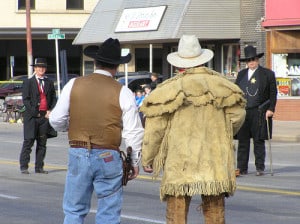
Do personal disagreements turn into community standoffs? Photo by Becky McCray
So, what is it that brings disunity to a community? Below is a list of some common culprits:
- Lack of trust between leaders and community members
- Resistance to change
- Leadership immaturity
- No defined purpose or vision
- Inconsistency in meetings
- Unfulfilled promises
- Competition for resources or power
- Unclear communication methods
- Self-centered interests
- Burnout and stress
- Allowing events to railroad relationships
To address disunity as a polarizing barrier to developing a thriving community, it’s essential to name the specific causes at play from the list above and implement strategies to mitigate them. Below is a list of improvements that can be made by individuals, organizations, or elected officials to find more unity in their community:
Open Communication
The foundation of any united community is open and honest communication. Offer encouragement and opportunities for community members to express their thoughts, ideas, and concerns. Create platforms for discussion, whether through community meetings, online forums, or social events. Effective communication ensures that everyone’s voice is heard, fostering an inclusive atmosphere where decisions are made collectively.
Include Everyone

When you include everyone, what will that look like? Photo by Becky McCray
Diversity is a strength, and inclusivity is key to building unity. Celebrate and respect the differences among community members, including cultural, social, and economic diversity. Develop programs that actively involve people from all backgrounds, ensuring that everyone has a place at the table. When people feel valued and heard, unity naturally follows.
Purpose and Goals
A united community needs a clear purpose and shared goals. These goals can be as simple as improving neighborhood safety, organizing cultural events, or addressing local environmental issues. When community members work together towards a common purpose, it strengthens their sense of unity. Ensure that the goals are transparent, achievable, and reflect the diverse needs and aspirations of your community.
Connect through Collaboration

How can you help people work together across groups? Photo via Deb Brown
Create opportunities for collaboration within your community. Encourage community members to form teams and work together on projects, whether it’s a local garden, community signage, or organizing social events. Collaborations not only improve the quality of life but also foster a powerful sense of belonging and shared responsibility.
Empower and Engage
Empower community members to take ownership of their shared spaces and challenges. When individuals feel a sense of responsibility for their community, they become more invested in its well-being. Encourage people to take on leadership roles, participate in local governance, and contribute to the betterment of the community.
Inspire Learning
Promote education and awareness about programs or initiatives within your community and from resources outside the community. When community members are well-informed, they are more likely to respect and support each other’s values, leading to a stronger sense of unity.
Celebrate Achievements

Find more ways to celebrate more successes in your community. Photo courtesy of Norfolk County, Ontario.
Celebrate the milestones of your work and recognize the efforts of individuals and groups who have contributed to the betterment of the community. Regularly holding events and celebrations not only instills a sense of community pride but also reinforces the feeling of unity and camaraderie.
Conflict Resolution
No community is without its conflicts. The key to maintaining unity lies in how these conflicts are managed. Establish an impartial conflict resolution process that allows for disagreements to be addressed constructively. Mediation and open dialogue can help community members find common ground and reach mutually acceptable solutions.
Commitment to Planning
Keeping unity in the community is an ongoing process that requires long-term planning. Establish a vision for the future and work collaboratively to achieve it. Encourage community members to stay engaged and commit to building a strong, unified community for generations to come.
Building unity in a community is a transformative process. By following these essential steps, your community can create a sense of belonging and togetherness that will empower its members to thrive and make a positive impact on society.
Shop Local tools: Easy Editorial, Letter to the Editor template to copy
Promote local shopping with a letter to the editor or editorial Step by step instructions Ready to promote local shopping to more of your community? Try an editorial or a letter to the editor. You can submit this to your local newspaper, share it in any organization newsletters, and post it on social media! Step […]
Promote local shopping with a letter to the editor or editorial
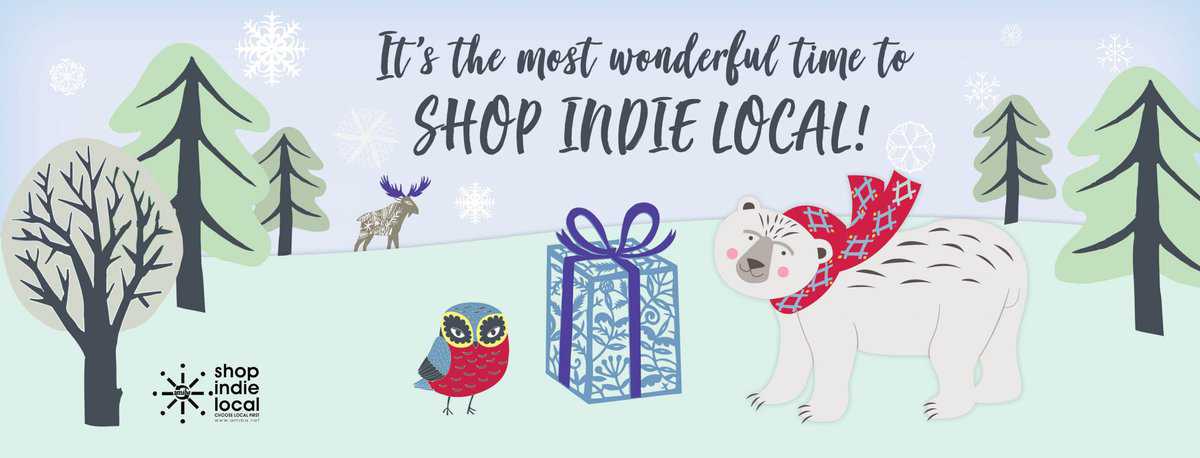
Step by step instructions
Ready to promote local shopping to more of your community? Try an editorial or a letter to the editor. You can submit this to your local newspaper, share it in any organization newsletters, and post it on social media!
Step 1. Easily grab these 3 simple numbers for your state or territory.
If you’re in the USA, go to Small Business Profiles at the Small Business Administration. Scroll down and click on your state or territory. You’re looking for these numbers:
- Number of small businesses
- Percentage of small businesses
- Percentage of employees
If you’re in another great country, try searching for each stat, like “Number of small businesses” plus the name of your state, territory or most relevant region. I just tried “number of small businesses New Zealand” and found out that there are 546,000 small business that are 97% of all businesses in New Zealand, plus they employ 29.3% of all employees.
Hot tip: Keep the PDF or website for your data open in a tab on your browser or on your phone, and it will be simple to find the numbers to fill in the template.
Here’s an example for the State of New Mexico:
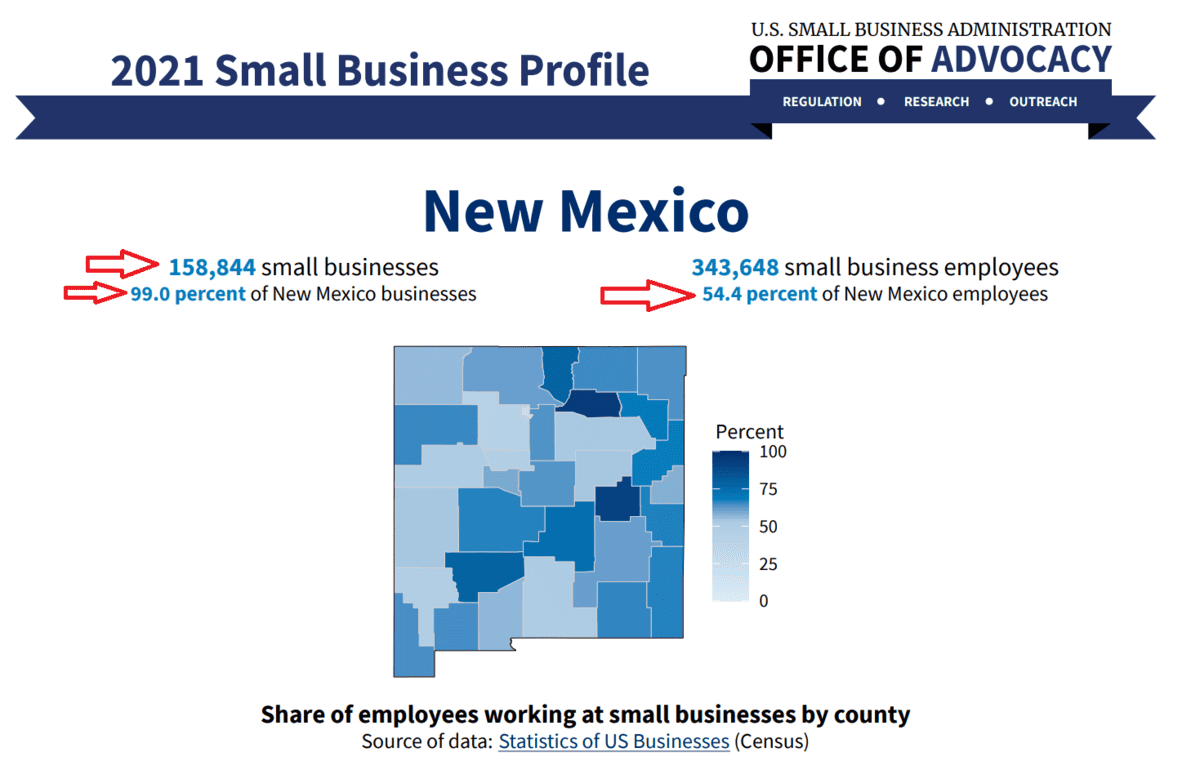
Step 2. Copy the template below to your favorite editor like Google Docs, Word, or even the notes app on your phone!
This template was provided by the Shop Indie Local promotion of the AMIBA – American Independent Business Alliance. They are a great resource for supporting local shopping all year long.
The Google Docs version of the template is here. (That link is subject to change in future years. If it’s no longer working, just copy the text from below.)
Step 3. Look for the sections in brackets {LIKE THIS} and fill them in.
You already know your state or territory name, and you just picked up those 3 simple numbers about small businesses. Just plop them into the note or document to customize it.
Step 4. Change any wording to make it sound more like you!
It’s ok to reword it, add something, or delete stuff that you would never say. The more personal you can make it, the better!
Don’t want to change a thing? That’s fine, too.
Step 5. Add a local story, or tell about a favorite local business.
The perfect place to do this is right after “entrepreneurial spirit.” Just start a new paragraph, and include a couple of sentences like this:
Holder Drug is the perfect example in our town. Not just the pharmacy, but also their amazing soda fountain! They’ve supported my family and yours for better health for generations, and they’re always one of the first donors to any local project.
Step 6. Submit it to a local newspaper.
Just email it to the editor or anyone you know at the paper. Check their website or a recent paper to find the email address. Or text a friend and ask!
Bonus points: Print it in organization newsletters.
If you belong to any club, church or organization, submit this for the next issue of the newsletter or email newsletter.
Double bonus points: Share on social media!
One super effective way to post on social media is to actually print out the letter on paper, sign it by hand, then post a photo of it to Instagram or Facebook with all the best local hashtags. And you can post the text in the comments. Multiply it by cross posting to local shopping or buy/sell groups on Facebook.
Don’t forget the #ShopIndieLocal hashtag!
That’s it! Ready to go? Here’s the template:
DRAFT Letter to the Editor Template: Shop Indie Local
In {ADD YOUR STATE/TERRITORY}, we pride ourselves on our independent thinking, ingenuity, and self-reliance — qualities reflected in our entrepreneurial spirit.
According to the Small Business Administration’s latest Small Business Profile, our state{OR TERRITORY} is home to more than {ADD NUMBER} small businesses (employing fewer than 500 people), comprising {ADD PERCENTAGE} percent of all {ADD YOUR STATE/TERRITORY} businesses.
Our small businesses also provide the most significant source of jobs across the state{OR TERRITORY}, employing {ADD EMPLOYEE PERCENTAGE} percent of all private-sector workers, compared to an average of 48 percent nationally.
Whether you run a business or not, we all have an essential role to play in supporting entrepreneurial success and community wealth. As many of us look to share gifts with friends, family, and coworkers, we also have the opportunity to give a gift to our community. When making holiday purchases, we ask you to “Shop Indie Local” and choose to spend your dollars at locally owned and independent businesses.
Why Shop Indie Local?
When you spend your dollars at locally owned retail businesses, more money returns to your local economy than if you spend that same dollar at a chain store. According to Civic Economics, when you spend a dollar at an independent business, about 48 cents returns to your local economy. (Spend it at a chain store and only 14 cents return; spend it at an online giant and only pennies return.) That 48 cents recirculate through a local economy, generating ripple effects that strengthen jobs, charitable contributions, and community prosperity. Capitalizing on this local multiplier effect is key to creating jobs and wealth in our community.
On the flip side, purchasing from Amazon or other remote online retailers provides virtually no economic benefit to our community. The American Independent Business Alliance calculates that 1 percent of the cost of an online purchase will go back into your community — only if the delivery person is a local resident.
Local, independent retail businesses help employ many more people than just those on the sales floor. They’re more likely to bank with your local banks and buy from other local businesses compared to absentee-owned companies. They’re also more likely to hire local service providers like accountants, graphic designers, sign-makers, webmasters, and various skilled positions — jobs for aspiring entrepreneurs.
Local non-profit organizations depend largely on contributions from local businesses. This support builds relationships that cement commitment to civic institutions like schools, churches, and fraternal leagues that aid economic prosperity, community cohesion, and trust.
If most of us shifted even one or two more purchases to independent, community-based businesses this season, we would create dramatic, positive changes in our local economies and help induce new jobs in our state{OR TERRITORY}.
So do yourself — and our community — a favor this year by shifting more of your spending to your local merchants, service providers, artisans, and locally owned and independent businesses. Along with helping your neighbors and community, you may just find that the Shop Indie Local spirit turns holiday shopping into a far more relaxing and enjoyable experience: one that rewards both you and your community.
{SIGN YOUR NAME HERE}
Shop Indie Local Week and Holiday Season, it’s way more than Shop Small Saturday
Guest post by Jen Risley, AMIBA Thank you for your commitment to building the local economy movement! Wishing you an inspiring Shop Indie Local Week with the entire community. My cat Shamu (above) can’t wait for Plaid Friday! One practical step: #ShopIndieLocal It doesn’t have to be overwhelming. Any local business or group can start by sharing social […]
Guest post by Jen Risley, AMIBA
Thank you for your commitment to building the local economy movement!
Wishing you an inspiring Shop Indie Local Week with the entire community. My cat Shamu (above) can’t wait for Plaid Friday!
One practical step: #ShopIndieLocal
It doesn’t have to be overwhelming. Any local business or group can start by sharing social media posts announcing your plans and adding #ShopIndieLocal to your posts.
Not just Saturday: Plaid Friday through Giving Tuesday
The week after Thanksgiving is a super busy one for the Shop Indie Local movement as we celebrate Plaid Friday, Small Business Saturday, Artists Sunday, Cider Monday, and Giving Tuesday.
Invite Independent Businesses to Plaid Friday
From TLC Monadnock: We invite businesses to serve as Plaid Friday Hubs in the Monadnock Region, NH. Back in 2009, what started with three hubs has grown to over thirty each year. View our invitation and adapt it to work for you!
Artists Sunday: Celebrating Local Artists, Creators, and Performers
From Artists Sunday: Artists Sunday, falling on November 26 this year, is the celebrated day after Thanksgiving dedicated to supporting local artists, creators, and performers. This year marks the fourth annual Artists Sunday, a unique shopping experience featuring over 4,000 professional artists and more than 500 non-profit art organizations, municipalities, and commercial entities across the nation.
“This Artists Sunday, let’s come together to celebrate and support the artists in our communities. It’s a day to fill our lives with beauty, creativity, and joy,” states Christopher V. Sherman, Executive Director of Artists Sunday
Why Cider Monday Matters
Celebrate Cider Monday to bring attention to the effects of online sales on your community. You love buying local, but the next thing you know … CLICK, you purchased that blender online from a business far from your community. It’s so easy! And your one purchase won’t really make a difference… or will it?
Unleash Generosity on Giving Tuesday
From Giving Tuesday: Whether it’s making someone smile, helping a neighbor out, or showing up for an issue or people we care about, we each have something to contribute. Identify your gifts, pick a cause that gets you fired up, and give back. Each seemingly small act turns a ripple into a wave of good, transforming society and building the world we all want to live in.
Get more ideas, graphics and support
When you become a partner for the holidays, you’ll join 150 Shop Indie Local Holiday Campaign partners from 42 states, including SmallBizSurvival! You’ll also find downloadable logos and other images. You can adapt our templates in Canva including Square Images, Banner Images and Mobile Video. There’s no deadline, and it’s definitely not too late to join.

Get graphics and idea support from AMIBA Shop Indie Local.
Expand your November and beyond:
Native American Heritage Month
From First Nations Development Institute: Celebrate Native American Heritage Month with First Nations! This month and all year, we recognize and honor Native contributions, history, culture, and ingenuity. We’ll be sharing ways to support Indigenous leaders, authors, creators, and communities all month, including:
- How to be an ally to Native Americans by reclaiming Native truth and challenging stereotypes.
- Resources to learn about Native American heritage, culture, and issues.
- How to support Native-owned businesses in your holiday shopping.
- Opportunities for your donation to make the largest possible impact for Native communities.
Neighborhood Toy Store Month
From ASTRA: Local toy stores aren’t just places where families shop; they are centers of creativity, imagination, and learning.
Learn more: Neighborhood Toy Store Month
Join the Choose Indie Local Movement for the next year
Get ready for year-round ideas and support with next year’s Choose Indie Local campaigns. Our Choose Indie Local program inspires and supports community members to boost the ripple effect of economic and community benefits we receive when we spend and invest dollars at locally owned businesses. Let’s make ripples!
To give us a jump start, we’re announcing our 2024 campaigns today.
- Choose Black-Owned
- Choose Indie Sustainable
- Move Your Money: Bank Local, Invest Local
- Bicycling Means Business
- Choose Indie Pride
- Independents Month
- Eat Indie Local
- Choose Indie Art
- Shop Indie Local
Think of the list above as a menu of options. Choose the campaigns that align with your overall goals and sign on to participate in one, two, or all nine.
What partners receive:
You’ll receive a list of resources to help you establish your goals and leverage each theme you sign up for.
We’ll list your business/organization as a partner on our campaign webpage(s).
One month leading up to the campaign and weekly once our campaign starts, you’ll receive updates to inspire you and keep your campaign momentum strong.
Sign onto Shop Indie Local for 2024 .
Subscribe to SmallBizSurvival for more Shop Indie Local updates throughout the year.
GEW: Rural Entrepreneurship in small villages in Portugal – panel video
Part of our Global Entrepreneurship Week celebration Nov 13-19, 2023. Speaking about small businesses, entrepreneurship and sharing rural stories Story and photos by Deb Brown I was invited to speak in Portugal by my friend and business associate Frederico Lucas. My first night in Lisbon I spoke at this event hosted at the coworking space NOW […]
Part of our Global Entrepreneurship Week celebration Nov 13-19, 2023.
Speaking about small businesses, entrepreneurship and sharing rural stories
Story and photos by Deb Brown
I was invited to speak in Portugal by my friend and business associate Frederico Lucas. My first night in Lisbon I spoke at this event hosted at the coworking space NOW Beato and broadcast live on Facebook. Focused on rural entrepreneurship, the panel had a lively conversation about the possibilities for their rural areas. And meeting the challenges their depopulated communities have.
In today’s global economy, entrepreneurs are always looking for new opportunities to innovate and create value. Small towns and villages are often overlooked and also can be a rich source of local knowledge and expertise. However, engaging with these communities can be challenging for people outside them, especially in areas with low population density and depopulation.
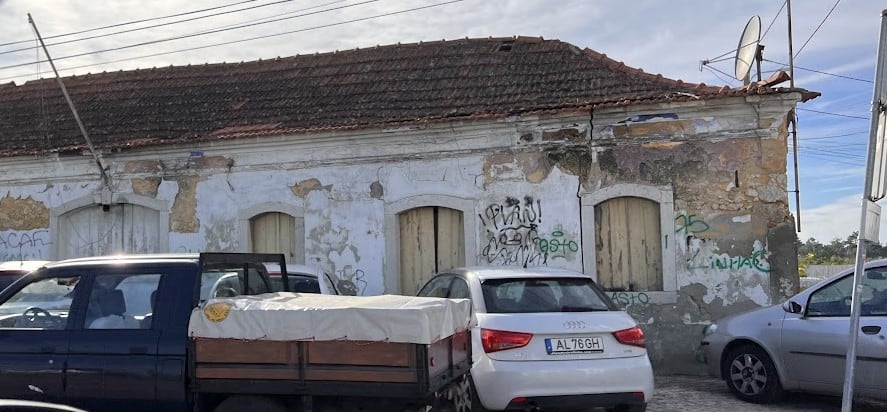
41 Small Villages Network Project in Rural Portugal
Ana Linares, from Novos Povoadores (“New Settlers”), and her team work with a group of small villages, 41 of them. There are very few people living there and few children, so the schools are closed. One town has 17 residents. Low density population is a problem. In the US we would call them ghost towns, in Portugal they call them depopulated.
Ana told us about this project. These 41 villages have created a network to develop tourism, but also to develop the community, and the social aspect of their economics. Because they are very small, if they were alone in trying to implement projects, it would be even more difficult. They started to organize and work together and use their synergies.
If one village has a festival, and another village has a walking trail, they can work together to offer a tourist experience that is more complete. Some towns have places to eat or sleep that can be added to the experience. Once the team connects with some of the few older people still living there, they find the community has great pride in their villages and is very open to innovation and doing new projects.
This initiative comes from the people in the community, not the municipality. As is the case in many small towns, they must start with what they have. The local government will not be the ones to begin the initiative. And the town is depopulated and doesn’t have the resources or people to get started. At least that is their belief. Often, there is no single group that wants to be responsible to start the project. Like in the United States, I’ve heard many people say, “The city ought to fix that.” And the people forget they ARE the city.

Christmas and community made this idea work
A successful example of this kind of project is the Christmas Village that asked for support and started with their own facilities and resources. Eventually the municipality joined in, but it was not quick.
This village is Cabeça, the first eco-sustainable Christmas village in Portugal. Supported by eco-design experts, local communities have engaged in the task of developing Christmas décor by using natural elements, agricultural and forest surplus, as well as wool from the Serra da Estrela Mountain area.
All the streets are ornamented with natural materials, and the town comes together a month or two before and works on all the ornaments and decorations. No plastic, only natural material. There is a large warehouse where all the ladies go to make the ornaments.
Capturing the stories
One inspiring example Ana talked about is the Museum of the Future, a new project in Portugal that captures the stories of people in small villages in video format. These stories have cultural, social, personal, and human dimensions, and can be used to inspire new ideas and products.
Places to work, meet, and celebrate for free
Another project Ana and her team worked on was reinventing and redesigning some small spaces for a handful of artists to work for free. They used circular economy design – where everything was designed and made with the local artisans in mind. Each artisan also has a retail space.
It’s also a space that is open to everyone in the village where you can have meetings and parties. It is a place to bring new people from out of the village. They can have the experience of what it is to live in a place that is open to artisans and community. There are many advantages to living in a place like this!
What does it take to be successful?
Engaging with small communities requires patience, empathy, and a willingness to listen and learn. It also requires a recognition that successful projects are not just about achieving technical goals, but also about building relationships and empowering communities.
One solution they use in Portugal is to adopt a co-creative and collaborative approach. By bringing the community along in every project, entrepreneurs can ensure that their initiatives are relevant, sustainable, and impactful. This approach also recognizes the value of people’s local stories and cultural heritage, which can be turned into resources for younger people to create new products or services, or to reinvent old ways of doing things.
Is this a utopian vision?
No. I don’t think so. Ana and the team at Novos Povoadores shared this remark on their website:
The globalized society is increasingly based on an economy without geography, a fact that allows us to look at the territory in a more inclusive way. In this context, it is possible to reduce the gap of regional disparities with advantages for new residents and for low-density territories. On the one hand, an undeniable increase in the quality of life, and on the other hand, the breaking of a cycle of territorial bleeding.
Photos from the coworking space NOW Beato in Lisbon, Portugal
Where the panel discussion was hosted.
Subscribe to Small Biz Survival.
Surviving the Peaks and Valleys of Seasonal Small Business in a Rural Ski Town
Part of our Global Entrepreneurship Week celebration Nov 13-19, 2023. Guest post by Mike Humphrey, Japan Skiing has been part of my life for as long as I can remember. I don’t know why my parents decided skiing would be our family sport. They were not avid skiers, and we didn’t live in a ski […]
Part of our Global Entrepreneurship Week celebration Nov 13-19, 2023.
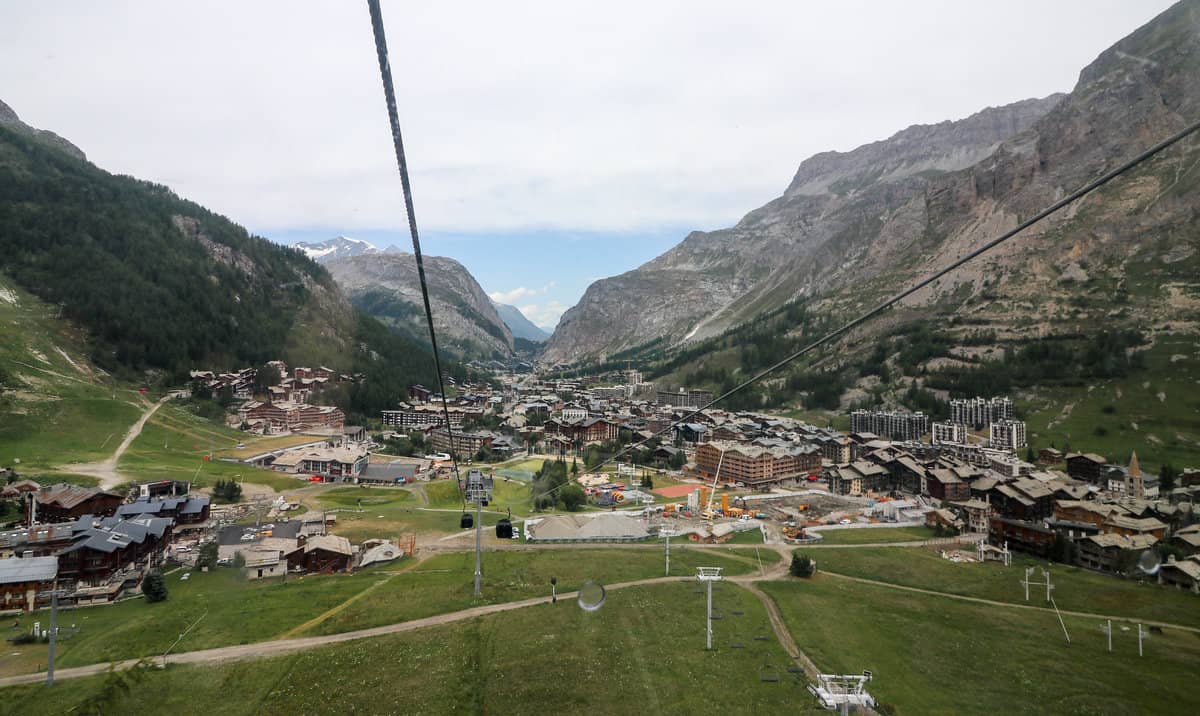
Photo CC by Joanbrebo
Guest post by Mike Humphrey, Japan
Skiing has been part of my life for as long as I can remember. I don’t know why my parents decided skiing would be our family sport. They were not avid skiers, and we didn’t live in a ski town. Whatever the reason, I was on skis at 3, and my love for the sport began. We would spend every weekend in the winter on the hill.
When I was 15, I became a ski instructor. Skiing is my passion. I love being out on the hill, and I love the mountains.
As I grew older, skiing was still part of my life, but it became a hobby. I went to university and got a job. I started a family, and things were going well. I would ski weekends at our small local hill, but it was slowly being relegated to an afterthought.
That all changed seven years ago when I left my corporate job. It was time for a life choice: continue with my career or make a change. With some savings in our account and dreams of powder turns, I leapt. I left my job and moved our family to a ski town in Japan.
It has been seven years since we moved to the mountains, and it has been filled with joys, challenges, and, of course, skiing. In that time, we have operated two hotels and a restaurant and weathered the storm of Covid. It has been a hell of a ride, and not without its difficulties. Despite the challenges, I would never return to working a corporate job.
Read on to discover the challenges we faced while building a business and our dream life in a small mountain town.
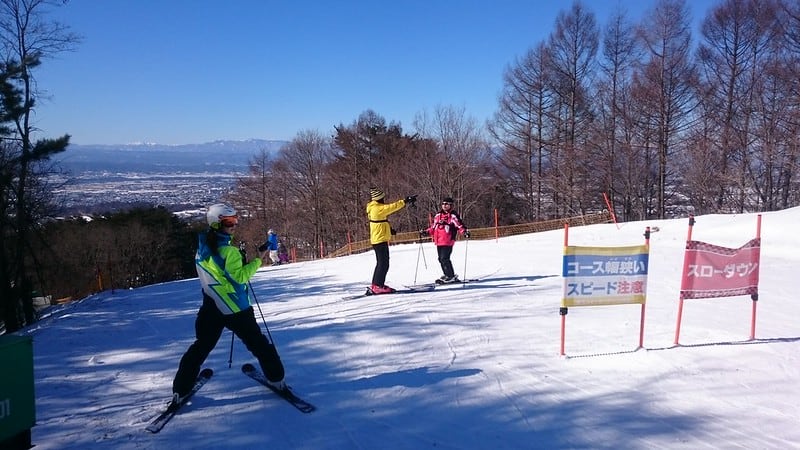
Photo CC by Cookie M
The Challenges of Running a Small Business in a Ski Town
1 – Seasonal Customers
The highs and lows of running a business in a seasonal destination, whether a ski town or a beach destination, are extreme. During the winter, the city’s population triples in size. In the span of 4 months, we get 400,000 tourists visiting our small village of 5,000 people.
The influx of customers is terrific for business but not always for sanity. Imagine the demand for your products skyrocketing for four months and then crashing back to almost zero as soon as the snow starts to melt.
As a business, you need to develop systems and processes to adapt to the extreme shifts in market demand.
Choosing a Business Model
There are generally two models to choose from when you decide what business to run. You can cater to tourists, or you can cater to residents. The best businesses are the ones that can manage to do both.
Catering to Travelers
With this model, you fully embrace the higher-paying tourists. You charge higher prices and focus on optimizing your returns for tourists. During the low times, you minimize your expenses and either shut the business down or drop prices and try to scrape by attracting lower-paying guests.
This is how we operated when we ran our hotel. We were very strategic with our opening dates and only worked during the peak season. During the slow times, we shut down the hotel, went into maintenance mode, and did upgrades.
This worked well when there were lots of guests, but if you have a terrible snow season or a global pandemic, for that matter, you can run through your reserves quite quickly.
Catering to Local Customers
Your goal here is consistent revenue throughout the year. You have to choose your prices to match the local market. Your customer base is smaller during the low season, but during the high season, your revenue jumps drastically.
This is the model we use to run our restaurant. We live and work in the community year-round and provide good food options at reasonable prices regardless of the season.
By establishing relationships with residents and business owners within the community, you can develop a strong clientele that will sustain you throughout the year. Those relationships help you to flourish during the high season when residents recommend your services to travelers in town.
Catering to Locals and Tourists
Matching both markets is a tricky needle to thread, and I haven’t seen many businesses do this successfully. Essentially, you must provide a service that can increase prices during peak times without alienating local customers. The closest we came to this was with the hotel, which had peak and low-time pricing. But this isn’t catering to local businesses; it’s just modifying your pricing to match traveler demand.
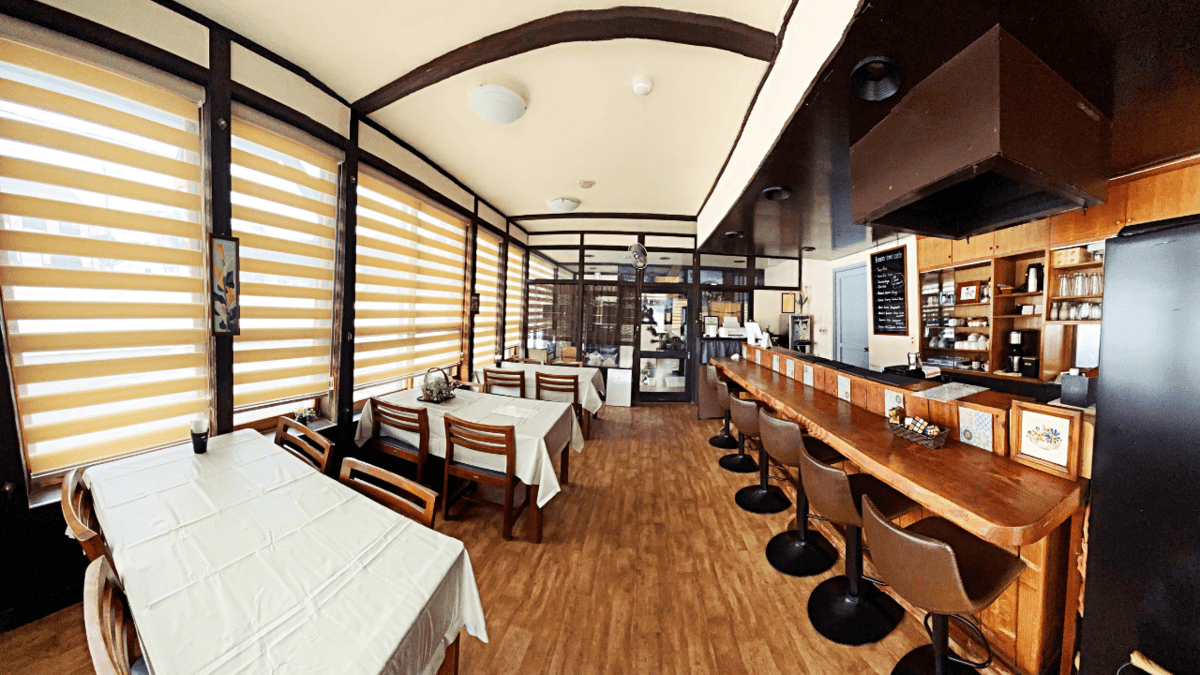
Photo provided by Mike Humphrey
2 – Staffing
Ski towns have some unique staffing issues that can be challenging for small businesses to overcome. The small local population combined with the boom and bust market makes staffing one of the most difficult things to deal with.
Staff Training
In a ski town, the money-making window is short, and staff is transitory. We hired 5 – 7 staff during peak season to help run the hotel. They would arrive early to mid-December, 1 – 2 weeks ahead of our first guests.
We rarely had repeat staff, and they had to be fully trained before the Christmas rush. It was trial by fire. You have to get them up to speed in 2 weeks so they can provide the best customer service possible. When the guests do start to arrive, it’s crunch time. You are running at full capacity almost immediately.
It’s the perfect storm. You need to hire the right people and have outstanding training programs and processes in place so they can hit the road running as quickly as possible.
Finding Good Staff is a Challenge
While this may be true for any industry, working in a ski town is appealing because you can ski. There is always a balance between finding a good employee and their desire to hit the hill.
As soon as the ski season starts, it’s too late to hire someone new. You better find the right people at the beginning and make sure they are doing a good job. Having to fire underperforming staff mid-season is a considerable risk.
You have to weigh the negative impact of keeping the employee on versus the risk of being short-staffed.
I have been through both experiences, and it was better to let the person go instead of hanging on.
Here are some tips for finding good staff.
Ask For Recommendations
Ask previous and current employees if they know anyone who would be a good fit. Check with friends and family or other business owners in the area.
Watch Out For Red Flags
Trust is critical; skills can be taught, but trust and work ethic can’t. During the interview process, look for signs that there may be issues. Identify them immediately and be upfront. Don’t move on until you feel entirely comfortable.
Check references. Call them and have an honest conversation. Ask what issues they had with the employee.
Use Contracts To Your Benefit
An employee contract goes a long way to establishing a good relationship with an employee. Reviewing and signing a contract makes your relationship official and keeps your employees committed.
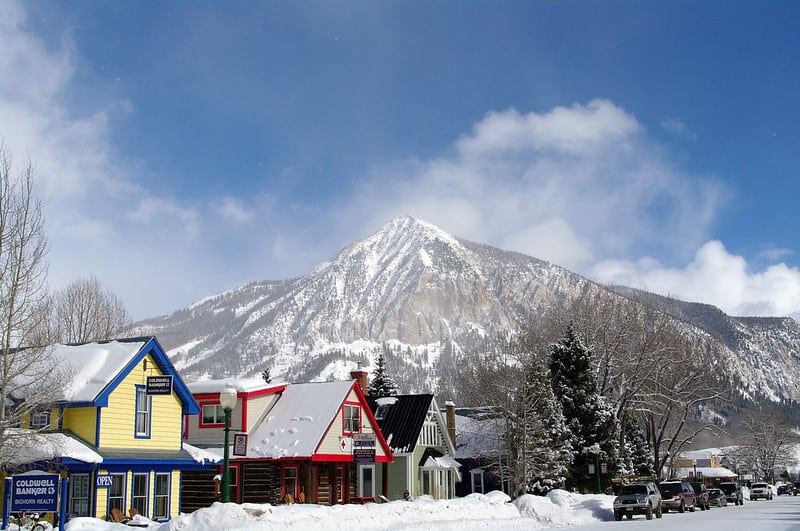
Photo CC by lamoix
Retaining Staff
The boom-bust nature of the ski industry means you can’t always keep staff all year long. The business can’t sustain employees during the low season. You always run a skeleton crew during the off-season and go into maintenance mode.
This means retaining good employees is hard. Expecting people to stick around and barely make enough money to live is unreasonable. Here are some ways to keep staff all year round.
Provide Extended Vacations
Give staff the chance to take time off during the shoulder seasons. They can take the opportunity to travel or go home to see family.
Reduce Staff Living Expenses
Consider alternative living arrangements or provide food through your business.
Collaborate with another business and offer a trade. Provide your services in exchange for cheaper accommodation for your staff.
It’s Hard Work
You have to make hay while the sun shines. For 4 – 5 months, you run flat out. Not only that, it’s playtime as well. You want to be out on the hill as much as you want to run your business. It’s easy to be understaffed and run your employees ragged. It’s a 4-month whirlwind of activity that can be hard to handle.
The critical takeaway is good hiring, training, and processes/systems. Watch for red flags when hiring staff; do not ignore your feelings about people. Don’t get me wrong, I have had some exceptional employees, but I’ve also had some horrible ones. Getting staffing right is crucial to making your small business work in a ski town.
One-on-one Training
When you’re in the thick of things, spending an hour or two with your employees teaching them may feel like a waste of time. But this is time well spent. An hour now could save you 10 – 20 times that time later in the season.
Learn From Other Businesses
We have friends who manage a hostel. They offered to take us through the building to show us how they managed their property. Here are some of the changes we made:
- We added a self-check-in process for late arrivals
- Better Signage
- Better local information Kiosk
Hire an Expert
If you’re unsure how to get better, find someone who has done it before and offer to pay them for their time. Have them watch how you run your business. Then, get them to make recommendations on how to improve.
Lessons Learned
After the season, talk with your employees about how things went. What things did you do well, and what could be improved? What pain points did the employees experience? Your perspective and the perspective of your employees will be different, and it’s essential to record what you learned.
Document
Solid documentation can be a great way to leverage your knowledge and compound your efforts. Keep records of everything you do. I like to use a Google Folder to build up a library of procedures. Whenever I need to use it, I review it and try to improve it. Things to document:
- Role Descriptions
- Job Postings
- Marketing Materials
- Standard Operating Procedures
- Annual Schedules
- Maintenance requirements
- Licensing renewals
This list will depend heavily on the type of business you run.
Implement
Last but not least, implement. If there is no action or change, then nothing will improve. I like to use project management software like Asana or Wrike to break everything down into manageable tasks. It will eventually get done as long as it’s written down and recorded.
3 – Cashflow Management
Cashflow is king, and managing your finances through a ski town’s boom and bust cycles is tough. Your business depends on tourists arriving at the start of the season to keep it running.
Building a reserve that sustains your business throughout the year is essential. But you also need to balance this against re-investing in your business. Cash sitting on the books doesn’t help your business grow and expand.
4 – Work-Life Balance
Running a business in a ski town is not all fun and games. You must be organized, stay on your toes, and manage your time well. It can be easy to get overwhelmed by the pace.
You can use the winter playground if you manage your business well and have the right staff. However, if you don’t, you will run yourself ragged, trying to keep everything afloat.
Final thoughts from a seasonal business
So, if you’re considering launching a business in a ski town, remember these points.
First, be prepared to put in a lot of hard work. It may not seem glamorous, but running a ski town business takes dedication and determination.
Second, be mindful of costs and stay on top of your finances. Knowing what you’re spending and where it’s going can help ensure you stay profitable.
Third, hire and train the right people to help you build a successful business. Finding and building a great team will make your life more enjoyable in the long run.
Finally, take advantage of where you live. Enjoy the mountains, the people, and all a ski town offers. It’s an incredible experience and one you won’t want to miss out on. I have seen too many business owners forget why they started their business and don’t get out and enjoy the lifestyle.
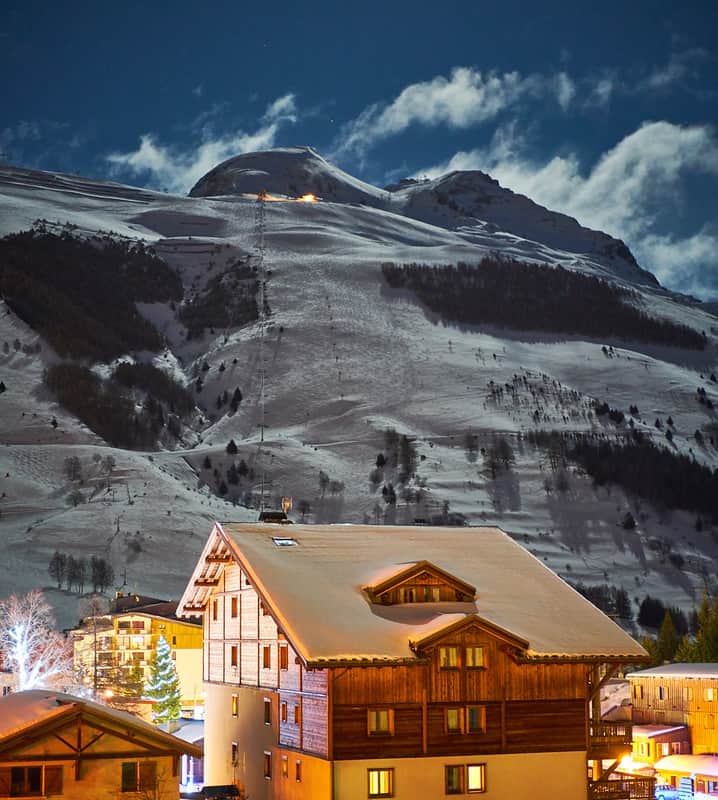
Photo CC by Radek Kucharski
Frequently asked questions: seasonal business
What are the peak seasons for running a business in a ski town?
The peak seasons are typically winter and summer when people come for skiing and summer outdoor activities.
Is it possible to maintain a steady income all year round in a ski town?
This largely depends on your business model. Some businesses are seasonal, while others offer services that are in demand year-round.
How do I attract local customers in addition to tourists?
Offering locals-specific discounts, involving your business in community events, and building a solid local reputation can all help attract local customers.
What challenges should I expect when running a business in a ski town?
Challenges may include:
- Dealing with the seasonal nature of business.
- Maintaining a steady workforce.
- Managing cash flow
How important is fostering relationships with other local businesses in a ski town?
Very important. Strong relationships with other businesses can help you stay informed about local trends, collaborate on joint initiatives, and create a support network.
Any advice on maintaining work-life balance while running a ski town business?
Schedule regular breaks, get involved in local activities, and ensure you take time for yourself and your family. Remember, enjoying your surroundings is part of the ski town experience!
About the author Mike Humphrey
Mike Humphrey is a writer and entrepreneur. He has operated several hotels and restaurants and founded mykhumphrey.com, where he writes articles about business, freelancing, remote work, and living abroad.

